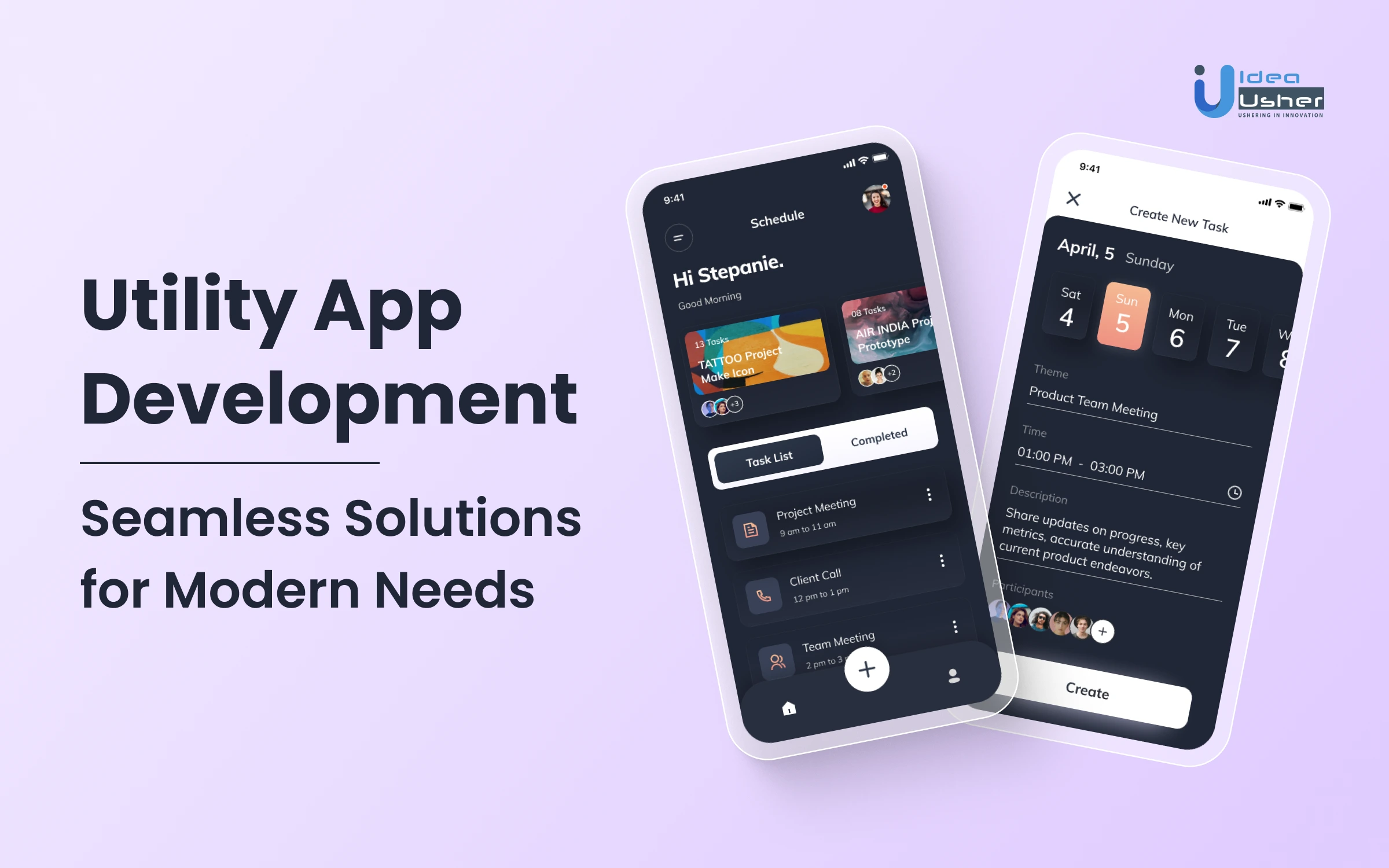
With rising demands for customized solutions worldwide, utility apps have emerged as indispensable tools catering to the needs of businesses and users alike. From simplifying tasks and enhancing productivity to providing convenience and instant access to information, utility apps offer a multitude of benefits.
For businesses, utility app development presents a unique opportunity to strengthen their brand presence, improve customer engagement, and tap into new revenue streams. These apps enable companies to offer value-added services, streamline operations, and foster customer loyalty by providing practical solutions tailored to their target audience.
At the same time, utility apps empower users by equipping them with tools to effortlessly manage their tasks, access essential services, and enhance their overall digital experience. Whether it’s a phone cleaner app to optimize device performance, a QR code scanner for seamless information retrieval, or a task management app for increased productivity, utility apps have become an integral part of our daily routines.
In this blog, we will delve deeper into the world of utility app development, exploring the various types of utility apps, strategies for monetization, and best practices for successful app creation.
What are Utility Apps?
Utility apps are mobile applications designed to provide practical solutions and enhance the functionality of smartphones and other digital devices. They serve a specific purpose, focusing on tasks that streamline daily activities and improve user experiences. Utility app development aims to create tools that offer convenience, efficiency, and optimization in various aspects of our lives.
These apps cover a wide range of functionalities, catering to diverse needs and interests. From phone cleaner apps that free up storage space and optimize device performance to QR code scanners that facilitate instant information retrieval, utility apps aim to simplify and enhance our digital interactions. They can also include apps for managing tasks, reminders, document scanning, language translation, and much more.
Trends and Market Stats
- By 2028, the utility app market is expected to reach a valuation of USD 7.8 billion, with a compound annual growth rate (CAGR) of 7.5% from 2022.
- Asia Pacific is the fastest-growing market for utility mobile apps, followed by North America and Europe.
- Mobile-based productivity and security utility apps are usually in the highest demand in the market.
- Google, Apple, Microsoft, and Avast are some of the major players in the utility app market.
- Other key trends include the integration of AI and ML and cross-platform functionality provided by app developers.
Types of Utility Apps Available in the Market
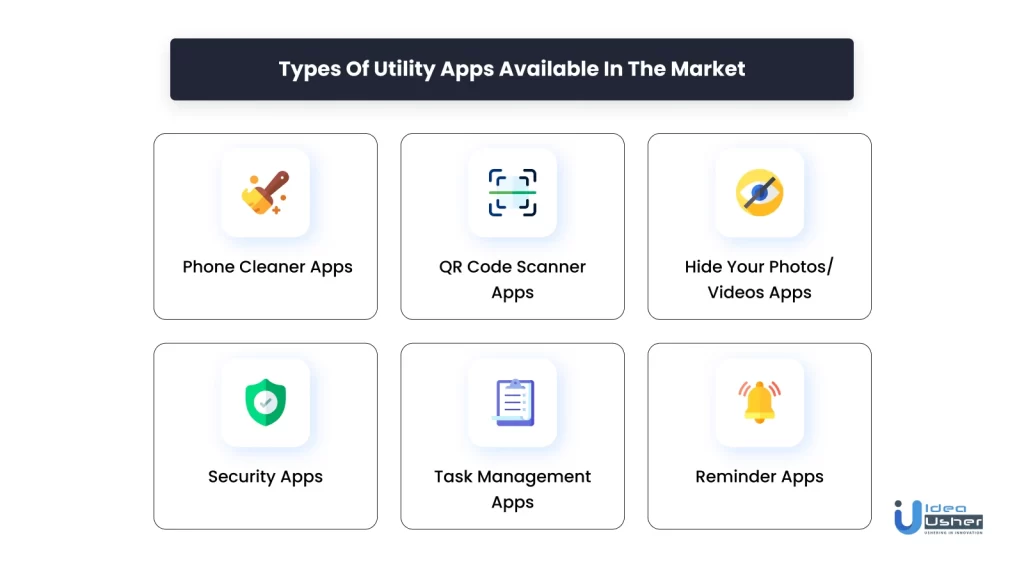
I. Phone Cleaner Apps
Phone cleaner apps are designed to help users free up space on their devices by removing junk files, cache, and other unnecessary data. They can also improve phone performance by closing background apps and identifying and removing malware.
Popular phone cleaner apps include:
- CCleaner: A popular and well-respected app that offers a variety of cleaning and optimization features.
- Norton Clean: A security-focused app that also includes several cleaning and optimization tools.
- Avast Cleanup & Boost: Another security-focused app that offers a comprehensive set of cleaning and optimization features.
- Files by Google: A free app from Google that offers a simple and user-friendly interface for cleaning up devices.
II. QR Code Scanner Apps
QR code scanner apps are used to scan QR codes, which are two-dimensional barcodes that store various types of information, such as website addresses, contact information, and payment details.
Popular QR code scanner apps include:
- Google Lens: A free app from Google that scans QR codes and identifies objects.
- QR Code Reader: A free app with a straightforward, easy-to-use interface for scanning QR codes.
- QR Code Scanner: A free app with additional features like scanning QR codes from photos and generating QR codes.
III. Hide Your Photos/Videos Apps
Hide your photos/videos apps are designed to help users keep their personal photos and videos private. These apps typically offer features such as password protection, hiding media from the gallery, and selective sharing.
Popular hide your photos/videos apps include:
- Keepsafe: A well-known app with various features for hiding photos and videos.
- Vaulty: A free app with a simple and user-friendly interface for hiding media.
- Private Photo Vault: A free app with features like password protection, hiding media from the gallery, and selective sharing.
IV. Security Apps
Security apps protect mobile devices from malware, viruses, and other threats. They also help secure personal information, such as passwords, credit card numbers, and social security numbers, from breaches and hacker attacks.
There are many popular security apps available, each with its own unique features.
- Bitdefender Mobile Security: Bitdefender Mobile Security is one of the most popular security apps on the market. It offers many features, including malware protection, virus protection, phishing protection, app lock, and a VPN.
- Avast Mobile Security: Avast Mobile Security is another popular security app. It offers similar features to Bitdefender Mobile Security but also includes a “Wi-Fi Security Scanner” feature that can scan public Wi-Fi networks for vulnerabilities.
- Norton Mobile Security: Norton Mobile Security is a comprehensive security app that offers a wide range of features, including malware protection, virus protection, phishing protection, app lock, a VPN, and a parental control feature.
V. Task Management Apps
Task management apps assist users in staying organized and productive. They typically offer features like creating and managing to-do lists, setting reminders, and tracking progress.
Popular task management apps include:
- Todoist: A widely used app that provides numerous features for managing tasks.
- Wunderlist: A free app with a straightforward and user-friendly interface for task management.
- Any.do: A free app with features like setting reminders, progress tracking, and collaboration on tasks.
VI. Reminder Apps
Reminder apps help users stay on top of their commitments by reminding them of important events and tasks. They typically offer features like creating and managing reminders, setting repeating reminders, and snoozing reminders.
Popular reminder apps include:
- Google Reminders: A free app from Google with a simple and intuitive interface for creating and managing reminders.
- Alarm Clock for Heavy Sleepers: A free app with features like custom alarms, snoozing, and the option to disable alarms if users don’t get out of bed.
- Timely: A free app with features like setting repeating reminders, snoozing, and collaboration on reminders.
These are only a few of the various types of utility application domains that are sought after. There are numerous other kinds of applications that you can make based on what your customer base tends to seek.
Why Should You Opt for Utility App Development for Your Company?
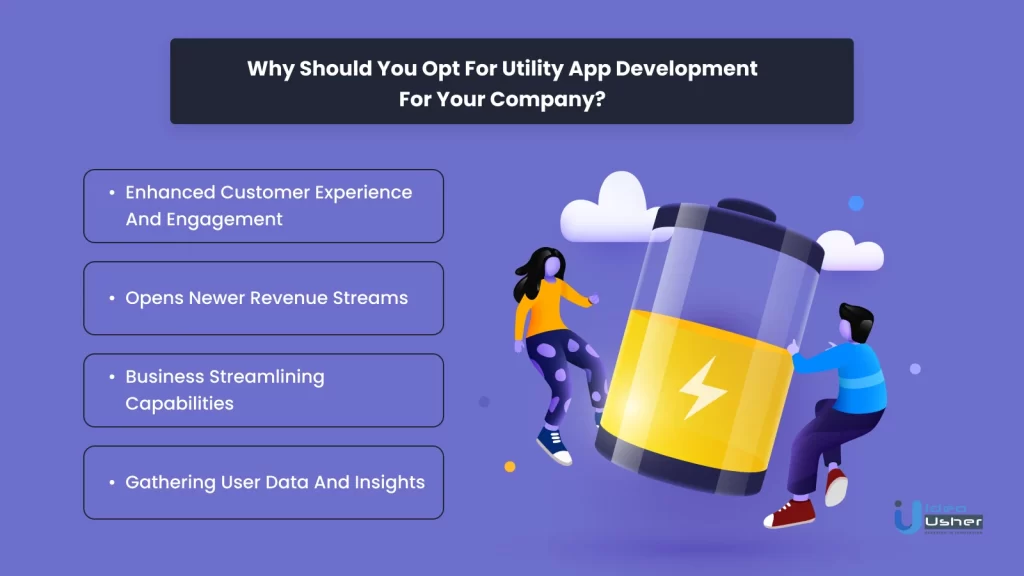
With the increasing demands of niche apps for solving specific user queries, utility app development has become a game-changer for businesses, offering a plethora of advantages that can propel your company to new heights. Here’s why you should seriously consider opting for utility app development for your organization.
I. Enhanced Customer Experience and Engagement
Utility app development offers a remarkable avenue to elevate customer experience and drive engagement to new heights. By developing a utility app tailored to your target audience’s needs, you can offer them a seamless and convenient way to interact with your brand.
By providing practical solutions through your app, you meet customer expectations and strengthen your brand presence. Whether it’s a phone cleaner app that optimizes device performance, a task management app that boosts productivity, or a QR code scanner app that simplifies information retrieval, utility apps empower users and foster loyalty.
II. Opens Newer Revenue Streams
Utility app development also presents lucrative revenue generation opportunities, expanding your business’s financial horizons.
You can generate revenue directly from the app through various monetization strategies, such as in-app purchases, subscriptions, or ad placements.
These apps usually have a high retention rate, as users rely on them for their daily needs, presenting ample opportunities for upselling or cross-selling additional products or services.
III. Business Streamlining Capabilities
Utility apps can also streamline and optimize your business operations, delivering notable efficiency gains and process enhancements.
For instance, developing a task management app can improve internal collaboration and productivity, ensuring everyone is on the same page and tasks are completed efficiently. This can increase efficiency, reduce manual errors, and enhance overall productivity.
IV. Gathering User Data and Insights
Last but not least, utility app development allows for gathering valuable user data and insights. You can gain deep insights into customer preferences by analyzing user behavior and preferences, which can inform your marketing strategies, product development, and overall business decisions.
In summary, developing a utility app is a strategic move that can benefit your company in multiple ways. From improving customer experience and engagement to generating revenue and streamlining operations, utility apps offer immense potential for growth and success.
Building a Successful Utility App
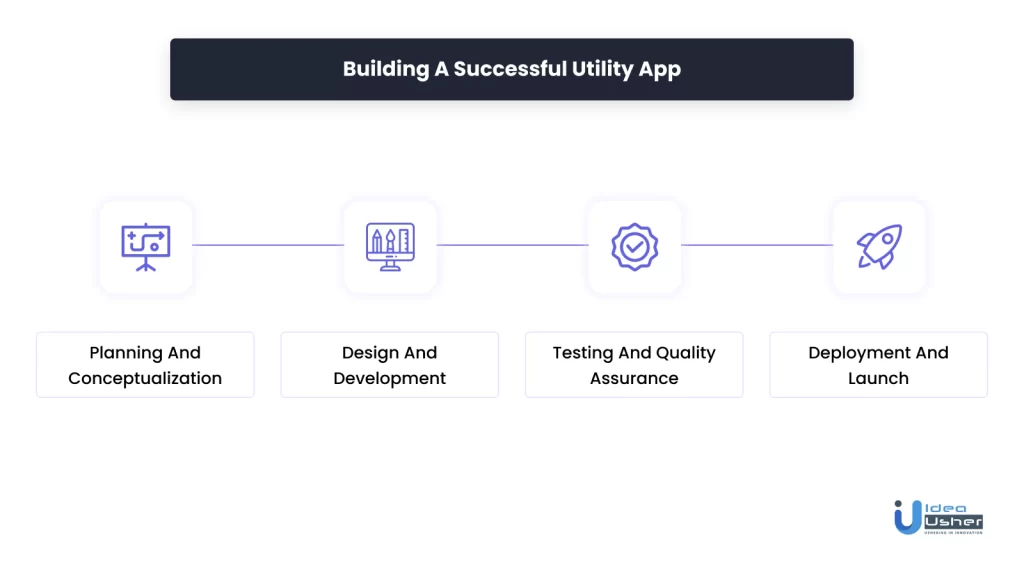
I. Planning and Conceptualization
When it comes to building a successful utility app, planning, and conceptualization play a crucial role. It’s important to dive into market research and truly understand what the users are looking for. By identifying their needs, you can create an app that addresses their pain points and stands out from the competition.
Once you are done researching the market and your target audience, next comes creating a comprehensive app development plan.
If you are confused about it, here is a five-step process that you can follow to curate your development plan:
- Start by documenting your app’s concept, goals, and features.
- Then, consider the user journey and create wireframes to visualize the app’s interface. Building a prototype allows you to gather feedback and validate your ideas.
- Make sure to consider technical factors, like the type (iOS, Android) and likewise platforms that are most popular among your target users. Break down development tasks, set milestones, and allocate resources effectively.
- User testing and feedback collection are also important throughout the development process. This lets you gather valuable insights and iterate on your app to enhance its functionality and user experience.
- Once all is done, you can launch your application on the preferred app stores.
Let’s have a look at these processes in more detail.
II. Design and Development
Designing an intuitive and user-friendly interface is crucial for the success of a utility app. Key considerations include simplicity, consistency, and visual appeal. Keep the interface clean and uncluttered, ensuring easy navigation and seamless user interactions. Utilize user-centered design principles to prioritize the most important features and provide a smooth user experience. We recommend using Adobe XD, Sketch, or Figma to navigate your design requirements.
Once designing gets completed, the next crucial factor that comes into play is your app’s responsiveness. Your app should adapt seamlessly to different screen sizes and orientations, ensuring a consistent user experience across smartphones, tablets, and even desktops. Employing technologies like HTML5, CSS3 and responsive frameworks like Bootstrap or Foundation can aid in achieving responsive design.
Robust backend development and efficient database management are equally vital for a reliable and scalable utility app. The backend usually handles data processing, user authentication, and interactions with external APIs. Technologies like Node.js or Django can be used for backend development, while cloud-based solutions like AWS or Google Cloud Platform can provide scalable and secure database management.
Considering all of this will ensure an exceptional user experience, seamless device compatibility, and efficient data management, leading to the success and growth of your app.
III. Testing and Quality Assurance
Thorough testing is vital to ensure a bug-free and reliable utility app. It helps identify and fix issues before the app is released, enhancing its overall quality and user experience.
Different testing methodologies play a key role in achieving this.
Functional testing verifies that each feature functions as intended, while usability testing focuses on evaluating the app’s user-friendliness and intuitive design.
Additionally, user feedback and beta testing provide valuable insights from real users, allowing further refinement and improvement.
Incorporating automated testing frameworks (e.g., Selenium or Appium) and bug tracking tools (e.g., Jira or Bugzilla) can streamline the testing and quality assurance process, ensuring a robust and polished utility app.
IV. Deployment and Launch
After successfully testing and fixing the errors, efficient deployment is the next step in providing your app to the market.
- Follow platform-specific guidelines for submitting your app to the App Store and Google Play Store. Prepare necessary app assets, such as icons, screenshots, and descriptions. Consider platform-specific features and design guidelines to provide a seamless user experience.
- Optimize your app’s listing to improve visibility and downloads. Use relevant keywords in the app title, description, and metadata. Encourage positive reviews and ratings.
- Continuously monitor and optimize your app store presence by regularly engaging with user feedback and making improvements.
- Leverage unique marketing channels to create awareness and drive downloads. Utilize social media, content marketing, influencer partnerships, and app review sites to reach your target audience.
By following these best practices, you can effectively deploy and launch your utility app on iOS and Android platforms while optimizing its visibility and downloads through app store optimization techniques.
Ways to Monetize a Utility App
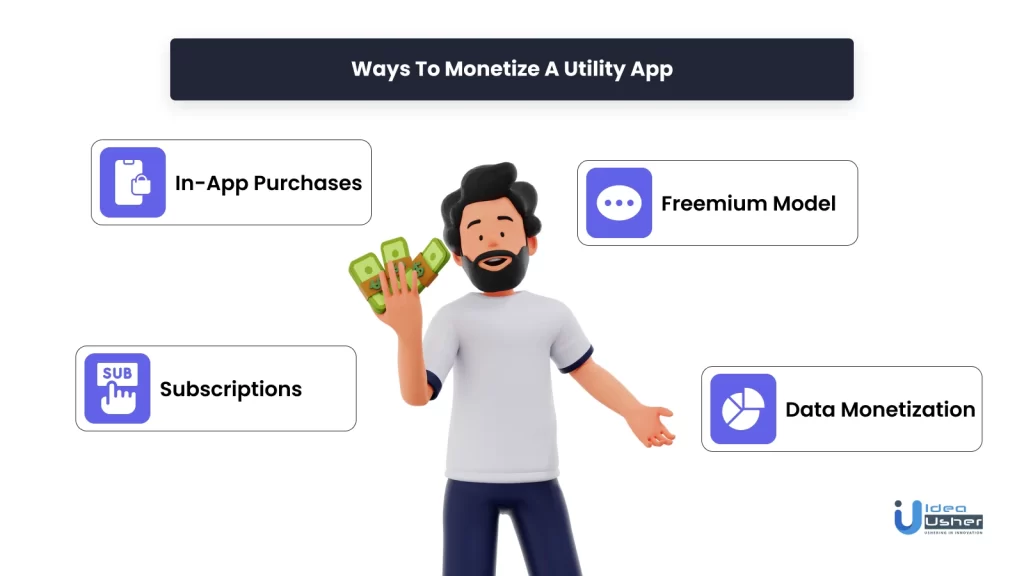
There are many ways to monetize a utility app. The most common strategies include:
I. In-app purchases
Many utility apps offer additional features or content that users can purchase within the app. For example:
- Todoist, a popular task management app, offers a premium subscription that unlocks advanced productivity features.
- CamScanner, a document-scanning app, allows users to buy credits for accessing premium scanning and OCR features.
II. Subscriptions
This strategy is effective for utility apps that provide ongoing value and regular updates. Examples include:
- Headspace, a meditation and mindfulness app, offers monthly or yearly subscriptions to access a library of guided meditations and relaxation techniques.
- 1Password, a password manager app, provides subscription plans for secure storage of passwords and personal information across devices.
III. Freemium model
Some utility apps offer a basic version for free and provide additional features or functionality through a paid upgrade. Examples include:
- Evernote, a note-taking app, offers a free version with limited storage and features, while a premium subscription unlocks enhanced storage, collaboration, and offline access.
- Strava, a fitness tracking app, offers basic tracking features for free, with a premium subscription offering advanced analytics and training plans.
IV. Data or service monetization
Utility apps that collect data or provide specialized services can monetize by selling insights or offering premium services. Examples include:
AccuWeather, a weather app, offers a premium subscription for detailed weather forecasts, radar maps, and severe weather alerts.
MyFitnessPal, a health and fitness app, provides a premium version with advanced nutritional analysis, meal planning, and goal-tracking features.
Each strategy has its pros and cons.
- In-app purchases can generate revenue from a smaller user base, but convincing users to purchase can be challenging.
- Subscriptions can provide recurring revenue, but competition from free or cheaper alternatives may be a hurdle.
- As for the freemium model, striking a balance between attracting a large user base and generating revenue from the premium offerings is the main challenge.
- Lastly, data or service monetization allows you to generate revenue by leveraging user data, but you still have to address privacy concerns and deliver value to users.
Depending on the app’s nature, target audience, and competitive landscape, you must make your strategic choice.
Wrapping Up
Utility app development presents immense opportunities for businesses and users alike. By developing such apps, businesses can engage users, improve productivity, and gain a competitive edge in the digital landscape. From phone cleaner apps to task management and reminder apps, utility apps streamline operations, enhance productivity, and improve customer experience. We explored various monetization strategies, such as in-app purchases, subscriptions, freemium, and data monetization, each with its own advantages and considerations. By embracing utility app development, businesses can unlock new revenue streams and engage customers on a deeper level.
As you embark on your utility app development journey, we encourage you to choose Idea Usher as your development partner. With our expertise and innovative solutions, we can help turn your app ideas into reality, ensuring a seamless user experience and impactful results.
Don’t miss out on the immense potential of utility apps.
Get in touch with us now!
FAQs
What is a utility app?
A utility app is a software application designed to provide practical functionality and assistance to users. It helps perform specific tasks, such as cleaning phone storage, scanning QR codes, managing tasks, and likewise.
How many types of utility apps are there?
Various types of utility apps are available, including phone cleaner apps, QR code scanner apps, photo/video hiding apps, task management apps, and reminder apps.
How much does it cost to develop a utility app?
The cost of developing a utility app depends on various factors, such as the complexity of features, platform compatibility (iOS, Android), design requirements, and development hours. Discussing your app idea with a development company like Idea Usher is best to get an accurate cost estimate.
How do utility apps make money?
Utility apps can make money through various monetization strategies, including in-app purchases, subscriptions, freemium, or data monetization strategies. Users can buy additional features or content, subscribe to access premium features, or view ads displayed within the app.
Can Idea Usher make a utility app for you?
Yes, Idea Usher specializes in app development, including utility apps. Our experienced team can help you transform your idea into a fully functional and user-friendly utility app tailored to your specific needs. Contact us to discuss your project and get started on developing your utility app.













Sayan Chakraborty